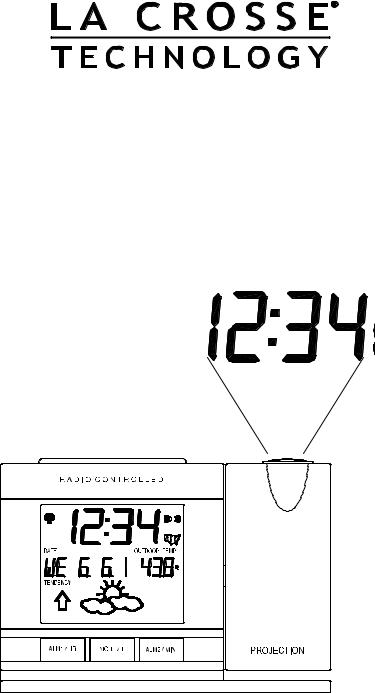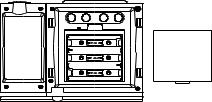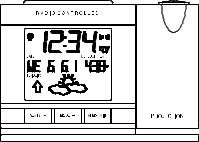La Crosse Technology WT-5442 User Manual

WT-5442 with TX6 Transmitter
433 MHz Radio Controlled Projection Alarm
Instruction Manual
1
TABLE OF CONTENTS
Topic |
Page |
Inventory of Contents/ Additional Equipment |
2 |
About WWVB |
3 |
Quick Set-Up Guide |
4 |
Detailed Set-Up Guide |
|
Battery Installation |
4-5 |
Program Mode |
|
Programming Sequence |
5 |
Function Buttons |
6 |
Time Zone Setting |
6 |
DST (Daylight Saving Time) Setting |
7 |
Adjustable Snooze |
7 |
Time Setting |
7 |
Date Setting |
8 |
12/24-Hour Setting |
8 |
Selecting °F or °C |
9 |
Features & Operations |
|
Features |
9 |
Radio-Controlled Time |
10 |
Projection |
10 |
EL Backlight |
10 |
Indoor Temperature |
10 |
Remote Temperature |
11 |
Time Alarm |
11 |
Changing Display Mode (viewing seconds) |
12 |
Weather Forecast |
12 |
Mounting |
13 |
Maintenance & Care |
14 |
Troubleshooting |
15 |
Specifications |
16 |
Warranty and Contact Information |
17 |
|
|
INVENTORY OF CONTENTS
1)WT-5442 Alarm Clock
2)TX6U Remote temperature transmitter
3)AC adapter/transformer
4)Instruction manual and warranty card.
ADDITIONAL EQUIPMENT (not included)
1)Three fresh 1.5V AA batteries (optional for alarm clock)
2)Two fresh 1.5V AA batteries (for remote transmitter)
Note: Alkaline batteries are recommended for use in both pieces.
2
FEATURES OF PROJECTION ALARM
Operation of these features are in section III.
1.Radio-controlled time and date
2.Projection of time and/or remote temperature
3.EL backlight
4.Six modes of date/seconds/temperature display
5.Indoor temperature
6.Remote outdoor temperature
7.Dual alarms
1) Adjustable snooze
ABOUT WWVB (Radio Controlled Time)
The NIST (National Institute of Standards and Technology—Time and Frequency
Division) WWVB radio station is located in Ft. Collins, Colorado, and transmits the exact time signal continuously throughout the United States at 60 kHz. The signal can be received up to 2,000 miles away through the internal antenna in the Projection alarm. However, due to the nature of the Earth’s Ionosphere, reception is very limited during daylight hours. The Projection alarm will search for a signal every night when reception is best.
The WWVB radio station receives the time data from the NIST Atomic clock in
Boulder, Colorado. A team of atomic physicists is continually measuring every second, of every day, to an accuracy of ten billionths of a second per day. These physicists have created an international standard, measuring a second as 9,192,631,770 vibrations of a Cesium-133 atom in a vacuum. For more detail, visit http://www.boulder.nist.gov/timefreq.htm. To listen to the NIST time, call (303)499-7111. This number will connect you to an automated time, announced at the top of the minute in “Coordinated Universal Time”, which is also known as
Greenwich Mean Time (GMT). This time does not follow Daylight Saving Time changes. After the top of the minute, a tone will sound for every second. It is possible that your Projection Alarm may not be exactly on the second due to the variance in the quartz. However, the clock will adjust the quartz timing over the course of several days to be very accurate; under 0.10 seconds per day.
QUICK SET-UP GUIDE
1)Insert two AA batteries into the remote transmitter.
2)Insert three AA batteries into the projection alarm and/or plug into wall.
Note: When starting or restarting your projection alarm the remote transmitter must be started first and then your alarm. After power is supplied (either battery or AC) ensure that no buttons are pressed for 10 minutes. This will allow time for the projection alarm to communicate with the remote transmitter as well as receive the WWVB signal.
3

Note: When using the AC adaptor, plug into the projection alarm first and then into the electrical outlet (this will help avoid pressing any buttons inadvertently).
3)Wait 10 minutes for WWVB reception and remote temperature.
4)If there is no WWVB reception, manually set the time and date
(instructions in the Program Mode).
5)Program the settings.
6)Mount the WT-5442 in a suitable location, where WWVB and transmitter signals can be received.
7)Mount the transmitter where remote temperature measurement is desired (on the North side of a house for example).
Note: The remote transmitter is weather resistant but not waterproof. High humidity and mist will not damage the transmitter but direct rain will. The maximum range between the transmitter and projection alarm is 80ft. open air (no obstructions). Any resistance (i.e. walls, furniture, etc) between the two will decrease the effective operating range.
8)The projector will activate and remain on if the alarm clock is plugged in. If only batteries are used, the projector will only be activated when a button is pressed.
9)See the “Features” section III. for instructions on projection direction, etc.
DETAILED SET-UP GUIDE
I.BATTERY INSTALLATION
A. REMOTE TEMPERATURE TRANSMITTER
1.Remove the battery cover. Observing the correct polarity, install 2 AA batteries. The batteries will fit tightly (to avoid start-up problems make sure that they do not spring free during installation).
2.Replace the battery cover.
4

B. PROJECTION ALARM
1. Remove the battery cover.
2. Observe the correct polarity, and install 3 AA batteries.
3. In addition or instead of inserting batteries, the AC adapter can be used. Simply plug
the adapter into the receptacle on the underneath of the alarm clock and then plug the adapter into the outlet.
4.Replace the battery cover.
5.The projector will activate and remain on if the alarm clock is plugged in. If only batteries are used, the projector will only be activated when a button is pressed. The projection is a red light, not harmful under normal usage, although care should be taken to not look directly into the light.
Note: After power has been supplied (battery or AC) a tone will sound, and the LCD (Liquid Crystal Display) will activate. The indoor temperature and the remote temperature will be displayed (within three to six minutes). Also, the time will appear as “-:--”. The WWVB search is automatically initiated, and a tower icon appears and flashes with the time colon (no tower icon will appear if the WWVB is too weak to be detected, which is typical during daylight hours and the time display will remain on “-:--”). While the WWVB search is being conducted various numbers will appear in the time display. After 10 minutes, the Projection Alarm will either display the WWVB time, or discontinue the search if the time is not found. If the search is cancelled “-:--” will remain in the time LCD. The Projection Alarm will conduct a WWVB search every hour until the first signal is found. Once the WWVB time is found, a search is automatically conducted nightly at midnight. If the signal is found at midnight, the tower icon will remain, if not, another search will take place every hour (until 6:00 am) until the signal is found successfully. If no signal is found during this period, the tower icon will not appear and the clock will search again at 12:00 am the next night.
II.PROGRAM MODE
To enter the Program Mode hold down the “SET” button for 1 second, until the time zone (“-5” default) flashes in the lower left. The Program Mode
Guide is laid out in a manner that allows you to program each function separately, or you can follow the instructions entirely to program the
Projection alarm. Complete programming is usually done for the initial set-up, and will require you to skip step 1 of programming sections “D” through “H”. Press the “SNOOZE” button at any time to exit the Program Mode, or wait approximately 15 seconds for the Projection Alarm to automatically return to normal operation.
5

A. PROGRAMMING SEQUENCE |
|
|
|
|
|
Default (Factory) Setting |
|
1. |
Time Zone Setting |
-5 (eastern standard time) |
|
2. |
Daylight Saving Time ON/OFF |
ON |
|
3. |
Adjustable Snooze |
10 Minutes |
|
4. |
Hour Setting |
12: AM |
|
5. |
Minute Setting |
:00 |
|
6. |
Year Setting |
01 |
(2001) |
7. |
Month Setting |
1 |
(January) |
8. |
Date Setting |
1 |
|
9. |
Day Setting |
MO (Monday) |
|
10. |
12/24-hour Mode |
12-hour |
|
B. FUNCTION BUTTONS
There are 8 function buttons; three on the front, four on the back and one on the top of the projection alarm. The function buttons are labeled: ALM1/HOUR, ALM2/MIN, light intensity icon, DISPL, light direction icon,
SET, MODE/+, and SNOOZE (the top bar).
C.TIME ZONE SETTING
1.Hold down the “SET” button for 1 second, the time zone (“-5” default) will flash in the Date LCD.
2.Press and release the “Mode/+” button to select the appropriate time zone. There are 13 time zones to choose from based relative to the international time standard of GMT (“Greenwich Mean Time”)(shown as “0h” on display).
3.From –5h to –8h, a US map with the highlighted time zone will also be displayed to the right of the time display.
4.Press and release the “SET” button to confirm the time zone setting, and to advance to DST (Daylight saving time) setting.
-4h |
Atlantic Time |
-5h |
Eastern Time (default setting) |
-6h |
Central Time |
-7h |
Mountain Time |
-8h |
Pacific Time |
-9h |
Alaskan Time |
-10h |
Hawaiian Time |
-11h, -12h |
Next two time zones West of HAW |
0h |
Greenwich Mean Time |
-1h, -2h, -3h |
Three time zones West of GMT |
6
